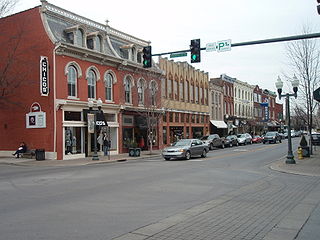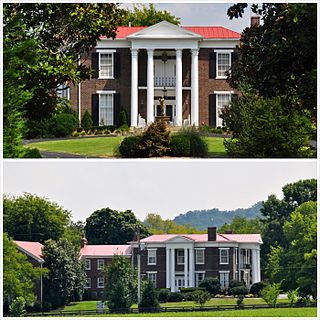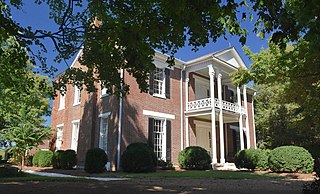
The Stokely Davis House was built in 1850 and included Italianate architecture and Greek Revival architecture.

The John M. Winstead Houses, also known as Pleasant Hill, are three antebellum houses in Brentwood, Tennessee that were together listed on the National Register of Historic Places in 1988.

The Henry P. Gray House is a building in Franklin, Tennessee, United States, dating from c.1845. It was listed on the National Register of Historic Places in 1988. It shows Greek Revival and Central passage plan architecture.

The Andrew Crockett House, also known as the Crockett-Knox House, is a property in Brentwood, Tennessee, United States that was listed on the National Register of Historic Places (NRHP) in 1988.

The Sherwood Green House is a property in Williamson County, Tennessee, near Nolensville, that was listed on the National Register of Historic Places in 1988.

The Franklin Hardeman House is a property in Franklin, Tennessee that was listed on the National Register of Historic Places in 1988. The property is also known as Sugar Hill and is denoted as Williamson County historic resource WM-291.

Franklin Historic District is a historic district in Franklin, Tennessee that was listed on the National Register of Historic Places in 1972. It was created to preserve historic commercial and residential architecture in a 16-block area of the original, downtown Franklin around the north, west, and south of the town square.
The Samuel F. Glass House is a property in Franklin, Tennessee that dates from 1859. It was listed on the National Register of Historic Places in 1988. It has also been known as Pleasant View.

The Sparkman–Skelley Farm is a property in Boston, Tennessee that was listed on the National Register of Historic Places in 2000. It has also been known as Sparkman Farm and as Skelley Farm. It dates from c.1846.

The James Johnston House is a property in Brentwood, Tennessee that dates from c.1840 and that was listed on the National Register of Historic Places in 1976. It has also been known as Isola Bella.

The Thomas Holt House is a property in Brentwood, Tennessee that dates from c.1840 and that was listed on the National Register of Historic Places in 1988. It has also been known as Holtland.

The H. G. W. Mayberry House, also known as Beechwood Hall, is a historic antebellum plantation house built in 1856 in Franklin, Tennessee.

The Owen Chapel Church of Christ is a property in Brentwood, Tennessee that was built in c.1860 and that was listed on the National Register of Historic Places in 1986. It includes Greek Revival and "Vernacular Greek Revival" architecture.

The William Martin House is a building and property in Brentwood, Tennessee, United States, that dates from c.1910 and was listed on the National Register of Historic Places (NRHP) in 1988. It has also been known as Boxwood Hall. It is a two-story house that was built c.1850 but was extensively remodeled into Colonial Revival style in c.1910. The NRHP listing was for two contributing buildings on an area of 1.7 acres (0.69 ha). The NRHP eligibility of the property was covered in a 1988 study of Williamson County historical resources.

The James P. Johnson House is a building and property in Thompsons Station, Tennessee, dating from 1854. It has been listed on the National Register of Historic Places since 1988. It has also been known as Laurel Hill. It includes Greek Revival and Central passage plan and other architecture.

Mooreland is a property in Brentwood, Tennessee that was built c.1838 and that was listed on the National Register of Historic Places in 1975.

The Dr. Hezekiah Oden House is a building and property in Franklin, Tennessee, United States, dating from c.1850 that was listed on the National Register of Historic Places (NRHP) in 1988. It has also been known as Walnut Winds. It includes Greek Revival, Central passage plan and other architecture. The NRHP listing included one contributing building, one contributing site and two non-contributing buildings on an area of 1 acre (0.40 ha).

The James Webb House is a property in Triune, Tennessee that dates from c.1850 and that was listed on the National Register of Historic Places (NRHP) in 1988. It has also been known as Kirkview Farm.

The Christopher H. Smith House, also known as the Queen of the Cumberland, is a historic house in Clarksville, Tennessee. It was built in the Antebellum era for a tobacco merchant. It is listed on the National Register of Historic Places.

The John and Philomena Sand Zimmerer House is a historic house in Seward, Nebraska. It was built in 1919 for John Zimmerer, the owner of a hardware store, president of the First National Bank of Seward, and co-founder of the Seward Equitable Savings and Loan Association. It was designed in the Jacobean Revival architectural style. It has been listed on the National Register of Historic Places since February 25, 1993.

















